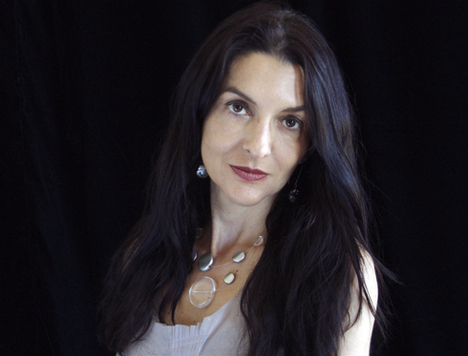ポリクセニ・パパペトルーPolixeni Papapetrou

© Polixeni Papapetrou
Polixeni Papapetrou is a photographer based in Melbourne, Australia. Her latest series of photographs “Between Worlds” were exhibited at LM D Gallery in Paris in May and June, 2010. Intrigued by magical essence that children holdsオーストラリア・メルボルンを拠点に、子ども達がもつ魔法のような力に魅了され写真作品を手掛けているポリクセニ・パパペトルー。「ビトウィーン・ワールズ」では動物のマスクをかぶった子ども達による、いくつもの曖昧な世界が切り取られた写真空間の中で繰り広げられている。
![]()
![]()
まず、自己紹介をお願いします。
![]()
ポリクセニ・パパペトルー。ギリシャ人の両親のもと、メルボルンで生まれ育ちました。写真作品を手掛けるようになって12年ほど経ちますが、2002年から子供時代のストーリーを展開する写真を撮るようになりました。子供の写真を撮るようになったのは、私たちの文化というものに対する考えを表現したかったからで、そのアイディアは子供らしさの象徴を通じて一番良く表現されると思ったからです。でも、もっと重要だったことは、子供の世界に魅了されたということです。
作品によく登場する主人公は私の二人の子供達、オリンピア(1997年生まれ)とソロモン(1999年生まれ)です。
![]()
![]()
写真家として活動するようになった経緯を教えて下さい。
![]()
子供の頃は、特に絵が上手だったわけでもなく、美術の授業の時などは才能がないなと感じていたので、他のことに興味を持つのは自然の流れでした。高校を卒業後は、メルボルン大学で法律を学び、2000年まで弁護士として働いていました。でも、大学で法律を勉強していた時に、アートや写真の世界を紹介してくれたアーティストに出会ったことで、ただ見るだけではなく、自らが写真を手掛けてみたいと思うようになりました。弁護士として働きながら、1993年からメルボルンにあるRMIT大学の定時制で写真を勉強することにしたのです。2000年になると、弁護士を辞めアーティストとして活動するようになりました。2007年には、メルボルンにあるモナッシュ大学で美術学の博士号を修得しました。
![]()
![]()
ビトウィーン・ワールズの写真はどこで撮影されているのですか?またそのロケーションを選んだ理由も教えて下さい。
![]()
ひとつを除く他の写真は、私の住むヴィクトリア州で撮影しました。ほとんどのロケーションは、メルボルンから車でそんなに遠くない場所です。作品に登場するいくつかの風景を選んだ理由は、空間のエッジ、時代の終わりを感じさせるような場所だったので。子供が動物の王国へ入る楽しみなど、不思議なことを伝える場所に感じたのです。作品の中で風景を使用することで、幅広い解釈のイメージを持てるし、登場する子供/動物の生き物がどこに住んでいるのかと思索を促してもくれます。
![]()
![]()
最も影響を受けたと思う物事や人を教えて下さい。
![]()
とても影響を受けているのは、19世紀の写真家のジュリア・マーガレット・キャメロン、(ルイス・キャロルとして知られる)チャールズ・ドジソン、オスカー・レイランダー、イルージョン、シンボリズム、イマジナリー、シアター、パフォーマンスで満たされる活人画伝統の中でパフォーマンスとして理解されている写真のすべて。好きなアーティストは、ジェフ・ウォール、シンディ・シャーマン、ジョエル・スタンフェルド、マーティン・パー、ウィリアム・エグルストン、ダイアン・アーバス、ラルフ・ユージン・ミートヤード。希望に溢れた、夢中にさせてくれる映画は、「不思議の国のアリス」(1966年、ジョナサン・ミラー監督)、「アザーズ」(2001年、アレハンドロ・アメナーバル監督)、「回転」(1961年、ジャック・クレイトン監督)、「狩人の夜」(1955年、チャールズ・ロートン監督)、「悲しみは空の彼方に」(1959年、ダグラス・サーク監督)、「欲望という名の電車」(1951年、エリア・カザン監督)、「アンドレイ・ルブリョフ」(1966年、アンドレイ・タルコフスキー監督)。
![]()
![]()
メルボルンでの生活や仕事について教えて下さい。また、メルボルンで好きなところもご紹介下さい。
![]()
メルボルン以外に住むことは想像もできませんね。世界中のいろんなところに行くのは大好きですが、メルボルンを拠点に仕事するのが気に入ってます。街はすばらしいですよ。交通の便も良く、面白い所ですし、海岸、農場地帯やハイカントリーなど異なる風景を体験するのにもそんなに遠くへ行く必要がありません。景観も、湿地や半熱帯なところから乾燥した乾いたところもあります。私は特に昔の金鉱地帯とその周辺が好きですね。メルボルンには種類豊富なワインや食べ物もあり最高ですよ。
![]()
![]()
メルボルンでおすすめの場所を教えてください。
![]()
レストランやカフェ:
Madame Sou Sou (227 Brunswick St, Fitzroy)
Blue Chillies (227 Brunswick St, Fitzroy)
Esposito (162 Elgin St, Carlton)
Bistro Vue (430 Lt Collins St, Melbourne)
Café Florentino (80 Bourke St, Melbourne)
Cumulus Inc (45 Flinders Lane, Melbourne)
![]()
場所:
Heide Museum of Modern Art (7 Templestowe Road, Bulleen)
ACMI (Federation Square, Melbourne)
Centre for Contemporary Photography (404 George St, Fitzroy)
State Library of Victoria (328 Swanston St, Melbourne)
China Town (Caledonian Ln, Melbourne)
![]()
ショップ:
Christensen Copenhagen (Level 1, 17-19 Albert Coates Lane, Melbourne)
Belinda (GPO Centre, Melbourne)
RPM (332 Lygon St, Carlton)
Christine’s Boutique (Basement 181 Flinders Lane, Melbourne)
![]()
![]()
Text: Mariko Takei, Papapetrou explores the ambiguities of various worlds by photographing children wearing animal head masks.
![]()
![]()
Please introduce yourself.
![]()
Polixeni Papapetrou. I was born in Melbourne to Greek parents and have lived in Melbourne all my life. I have been making photographs for about twenty years, but since 2002 my work has involved making images that tell stories about childhood. I started making pictures about childhood because I wanted to express ideas about our culture that are best portrayed through the symbol of the child, but more importantly, I am intrigued by the world of childhood.
The main protagonists in my work have been my two children, Olympia (born 1997) and Solomon (born 1999).
![]()
![]()
When and how did you start your career as a photographer?
![]()
Growing up as a child, I was not especially good at drawing and always felt inadequate during art classes so I focused on other academic interests that came more naturally to me. After leaving school, I studied law at Melbourne University and began my professional working life as a lawyer. I worked as a lawyer until 2000. However, while I was a law student I met an artist who introduced me to the world of art and photography. My interest in photography went beyond looking at it and I wanted to start making pictures. I began studying photography as a part-time student at RMIT University Melbourne in 1993, while I was still working as a lawyer. In 2000 I left legal practice to work as an artist. In 2007 I graduated with a PhD in fine arts from Monash University, Melbourne.
![]()
![]()
Where did you shoot the photos of Between Worlds and how and why did you choose the locations?
![]()
The photographs, with the exception of one, were made in the state of Victoria where I live. Most of the landscape locations I used are within a short driving distance from Melbourne. I selected some of the landscapes because it felt as if they were at the edge of a space or at the end of an epoch—conveying some of the wonder that children might entertain in entering the animal kingdom. I think that the use of landscape in the work allows the image to have a wide range of interpretations and encourage contemplation of where these child/animal beings might live.
![]()
![]()
What or/and who do you think you get influenced by the most?
![]()
I have been greatly inspired by 19th century photographers such as Julia Margaret Cameron, Charles Dodgson (more commonly known as Lewis Carroll) and Oscar Rejlander, all of whom understood photography as performance in the tableaux tradition full of illusion, symbolism, the imaginary, theatre and performance. . Some favourite artists include, Jeff Wall, Cindy Sherman, Joel Sternfeld, Martin Parr, William Eggleston, Diane Arbus and Ralph Eugene Meatyard. There are also films that are totally uplifting and transporting such as Alice in Wonderland (1966, Jonathan Miller), The Others (2001 Alejandro Amenábar), The Innocents (1961 Jack Clayton), The Night of the Hunter (1955 Charles Laughton), Imitation of Life (1959 Douglas Sirk), A Streetcar Named Desire (1951 Elia Kazan) and Andrey Rublyov (1966 Andrei Tarkovsky).
![]()
![]()
How do you like to live and work in Melbourne? How’s is the city like? Please introduce your favorite part of Melbourne.
![]()
I can’t imagine living anywhere else in the world. I love to visit places all over the world, but I work best in Melbourne. The city is amazing because it is accessible and interesting and I don’t have to go very far to experience vast differences in landscape such as the coast, the farm districts or the high country. The landscape varies from wet and semi-tropical in parts to dry and dusty in others. I especially love the old gold mining regions and their surrounds. The variety of the food and wine in Melbourne is also fantastic and I haven’t even started on the cultural scene.
![]()
![]()
Could you tell us your favorite places of Melbourne?
![]()
Restaurants and cafes;
Madame Sou Sou (227 Brunswick St, Fitzroy)
Blue Chillies (227 Brunswick St, Fitzroy)
Esposito (162 Elgin St, Carlton)
Bistro Vue (430 Lt Collins St, Melbourne)
Café Florentino (80 Bourke St, Melbourne)
Cumulus Inc (45 Flinders Lane, Melbourne)
![]()
Places;
Heide Museum of Modern Art (7 Templestowe Road, Bulleen)
ACMI (Federation Square, Melbourne)
Centre for Contemporary Photography (404 George St, Fitzroy)
State Library of Victoria (328 Swanston St, Melbourne)
China Town (Caledonian Ln, Melbourne)
![]()
Shops;
I like shopping in the numerous vintage clothes and furniture shops peppered along in Smith St and Brunswick St, Fitzroy
Christensen Copenhagen (Level 1, 17-19 Albert Coates Lane, Melbourne)
Belinda (GPO Centre, Melbourne)
RPM (332 Lygon St, Carlton)
Christine’s Boutique (Basement 181 Flinders Lane, Melbourne)
![]()
![]()
Text: Mariko Takei
